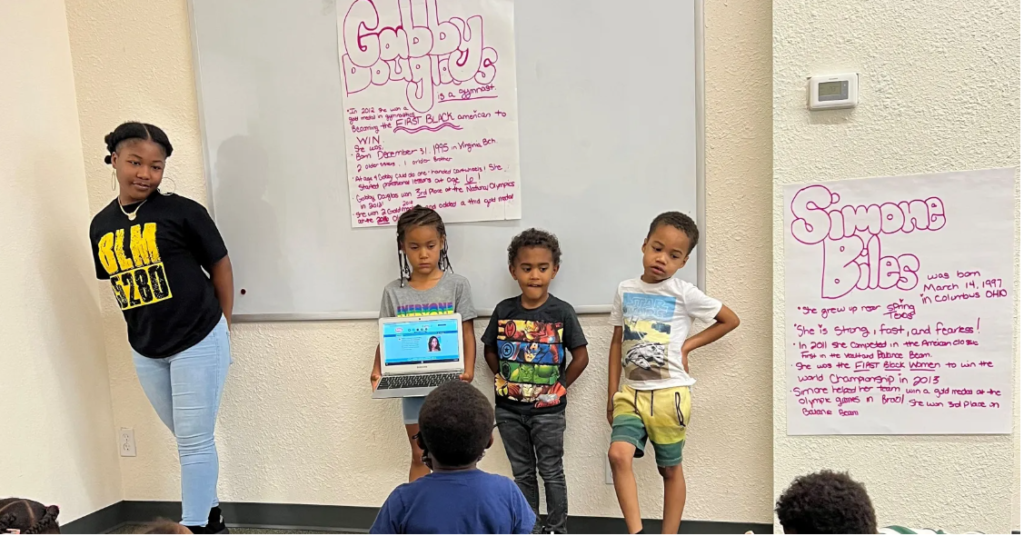Melanie Asmar, Chalkbeat Colorado
Denver Public Schools has the largest test score gaps in all of Colorado between white and Black students, and between white and Hispanic students, in both literacy and math.
Data released last week from standardized tests Colorado students took last spring shows that white students in Denver scored near the top in the state, while Black and Hispanic students scored near the middle. Those yawning gaps mean Denver is not serving the Black and Hispanic students who make up the majority of its population as well as it does white students.
For example, 72% of white Denver students scored at or above grade level on state literacy tests, known as Colorado Measures of Academic Success, or CMAS, but just 26% of Black and 24% of Hispanic students did. The gaps are 46 and 48 percentage points, respectively.
Denver’s gaps are much wider than the statewide average of 27 percentage points between white and Black students, and 29 percentage points between white and Hispanic students.
And they’re growing. Though Denver has been trying for years to better serve Black and Hispanic students and narrow the gaps, they’re bigger now than before the pandemic.
Both district and community leaders noted that the pandemic disproportionately impacted Black and Hispanic families. But parents said the gaps are unacceptable.
“We have within DPS institutional, systematic racism — and it shows within the data,” said Robert Giron, whose family members identify as both Apache and Mexican-American. Three of his children graduated from Denver schools and one is still in high school. “If we don’t take and pull off that scab of racism within the system, our demographics are never going to get educated.”
Superintendent Alex Marrero, who has been on the job a year, acknowledged the gaps.
“Those gaps had been part of DPS even pre-pandemic,” he said. “I don’t want the community to feel like this is something new. It is something that has been — and it shouldn’t have been.
“Now it’s more in our face, so we have to accept and embrace it.”
Marrero said this year’s test scores serve as a new baseline from which to grow. His first strategic plan, released publicly this week, calls for improving the number of students reading and doing math on grade level by 10 percentage points by 2026 and even more for “some student groups” — a recognition that the district has big gaps to close.
Denver Public Schools also has the 12th largest gap on state math tests between students who qualify for subsidized lunch, an indicator of poverty, and those who don’t. In literacy, it has the 15th largest gap by socioeconomic status. (The Cheyenne Mountain district has the largest gap in math and the Telluride district has the largest gap in literacy.)
Marrero ticked off a list of strategies to address Denver’s gaps, including shrinking the size of a “bloated” central office to funnel more money into schools and reorganizing the way schools are grouped for collaboration. Instead of grouping schools regionally, Marrero has grouped them by type, such as Montessori or dual-language.
Schools will also shift how they teach students who are behind, said Deputy Superintendent of Schools Tony Smith. Instead of focusing on remediation, which means teaching a third-grader the first-grade skills they haven’t yet mastered, schools will use tools and strategies to teach that third-grader grade-level skills in a way they can understand. Some of those tools, such as virtual tutoring, were sharpened during the pandemic, he said.
Smith called it ending “this disease of remediation and that perpetual cycle of ‘You don’t know. You don’t know.’ And imbue people with their own intelligence.”
“There aren’t fancy bullets or initiatives that are going to get us out of this equity gap,” he added. “If so, we would have experienced those already. … We’re really getting back to the basics.”
But not all parents are convinced Denver’s plan goes far enough. In light of the test score gaps, parent Tiffany Grays, who chairs Denver Public Schools’ Black Family Advisory Council, said she is skeptical of the district’s new catchphrase: Every Learner Thrives.
“What does that mean?” she said. “Because clearly our learners are not thriving.”
The strategic plan, Grays said, seems to be “identifying what we already know, but not identifying the specific steps that are going to be taken to accomplish these goals. You can put progress measures in place, but if those measures are based on a system that is oppressive to certain populations, then you’re just perpetuating the exact thing you’re saying you want to mitigate.”
Dwayne Meeks, an African-American parent who serves on the District Accountability Committee, said Denver needs to identify the root of the gaps.
A Chalkbeat analysis shows that when compared with white students in all 178 Colorado districts, Denver’s white students scored fourth highest in literacy. Denver’s Black students scored 22nd highest among Black students in Colorado. Hispanic students were 66th highest.
Parent Laura Rodriguez said she’s frustrated. A Spanish-speaking mother of four, Rodriguez also serves on the District Accountability Committee. Students don’t have books in their language or that reflect their culture, she said, and the specialists who are supposed to help catch up students who are behind only speak English.
Frequent changes cause confusion, she said: As soon as students and families get used to a new program, the district changes it.
“DPS always talks about equity and yet it’s clear that there is none,” Rodriguez said. “The people of our community feel as though they are not being heard.”
Melanie Asmar is a senior reporter for Chalkbeat Colorado, covering Denver Public Schools. Contact Melanie at masmar@chalkbeat.org.
Chalkbeat is a nonprofit news site covering educational change in public schools.




